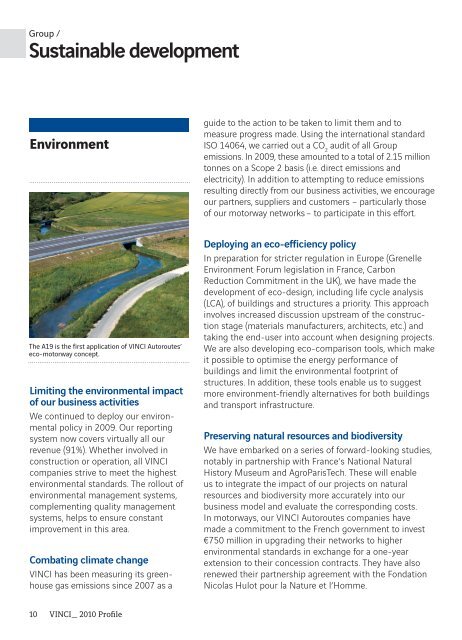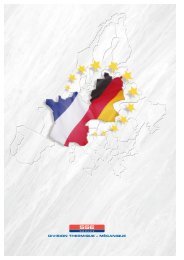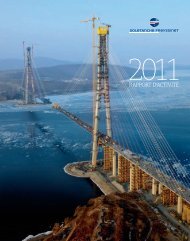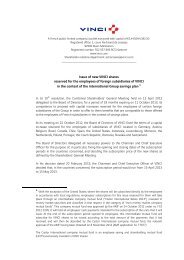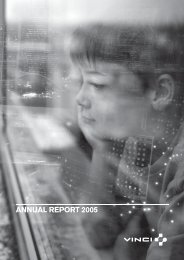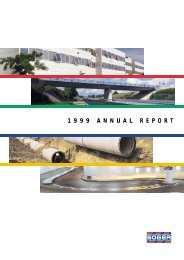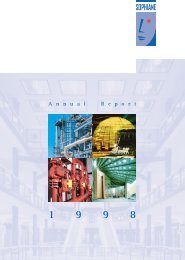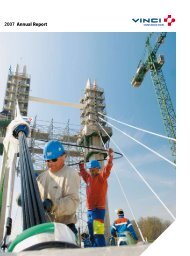VINCI - Profile 2010
VINCI - Profile 2010
VINCI - Profile 2010
- TAGS
- vinci
- publi.vinci.com
You also want an ePaper? Increase the reach of your titles
YUMPU automatically turns print PDFs into web optimized ePapers that Google loves.
Group /<br />
Sustainable development<br />
Environment<br />
The A19 is the first application of <strong>VINCI</strong> Autoroutes’<br />
eco-motorway concept.<br />
Limiting the environmental impact<br />
of our business activities<br />
We continued to deploy our environmental<br />
policy in 2009. Our reporting<br />
system now covers virtually all our<br />
revenue (91%). Whether involved in<br />
construction or operation, all <strong>VINCI</strong><br />
companies strive to meet the highest<br />
environmental standards. The rollout of<br />
environmental management systems,<br />
complementing quality management<br />
systems, helps to ensure constant<br />
improvement in this area.<br />
Combating climate change<br />
<strong>VINCI</strong> has been measuring its greenhouse<br />
gas emissions since 2007 as a<br />
10 <strong>VINCI</strong>_ <strong>2010</strong> <strong>Profile</strong><br />
guide to the action to be taken to limit them and to<br />
measure progress made. Using the international standard<br />
ISO 14064, we carried out a CO 2 audit of all Group<br />
emissions. In 2009, these amounted to a total of 2.15 million<br />
tonnes on a Scope 2 basis (i.e. direct emissions and<br />
electricity). In addition to attempting to reduce emissions<br />
resulting directly from our business activities, we encourage<br />
our partners, suppliers and customers – particularly those<br />
of our motorway networks – to participate in this effort.<br />
Deploying an eco-efficiency policy<br />
In preparation for stricter regulation in Europe (Grenelle<br />
Environment Forum legislation in France, Carbon<br />
Reduction Commitment in the UK), we have made the<br />
development of eco-design, including life cycle analysis<br />
(LCA), of buildings and structures a priority. This approach<br />
involves increased discussion upstream of the construction<br />
stage (materials manufacturers, architects, etc.) and<br />
taking the end-user into account when designing projects.<br />
We are also developing eco-comparison tools, which make<br />
it possible to optimise the energy performance of<br />
buildings and limit the environmental footprint of<br />
structures. In addition, these tools enable us to suggest<br />
more environment-friendly alternatives for both buildings<br />
and transport infrastructure.<br />
Preserving natural resources and biodiversity<br />
We have embarked on a series of forward-looking studies,<br />
notably in partnership with France’s National Natural<br />
History Museum and AgroParisTech. These will enable<br />
us to integrate the impact of our projects on natural<br />
resources and biodiversity more accurately into our<br />
business model and evaluate the corresponding costs.<br />
In motorways, our <strong>VINCI</strong> Autoroutes companies have<br />
made a commitment to the French government to invest<br />
€750 million in upgrading their networks to higher<br />
environmental standards in exchange for a one-year<br />
extension to their concession contracts. They have also<br />
renewed their partnership agreement with the Fondation<br />
Nicolas Hulot pour la Nature et l’Homme.


